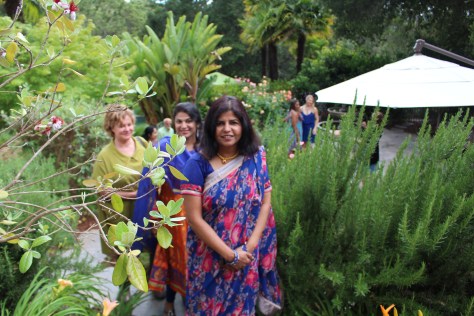Okay, here I was prepping my garden on the Friday before of my upcoming garden party, which was on Sunday. I am potting up a gorgeous pale pink geranium cutting that I wanted to showcase indoors at the party. I tussle a pot that had some potting soil in it and I get ready to pot up my geranium and what do I see? A ton of yellow jacket bees! One bit me on my arm, another bit me on my foot, and one was stuck to my leg ready to bite. I ran like a mad woman. When I finally caught my breath inside my house, I made sure no bee followed me in or got stuck in my mane of rough curly black hair. Then I slowly ventured back out with a coat on this time, and from afar took a look at my potting bench. And I see a group of yellow jackets just hovering on the ground in that area.

Honestly I was confused. I have been working in my garden all week getting ready for this year’s Garden Party and Ladies Lunch, and I was potting plants and what not all week, and this just happened out of the blue. It’s like I disrupted some hive, and now I was afraid I might have to cancel the party or just tell the ladies to stay inside. Do you see the irony in this folks? A garden party where you are told not to stroll in the garden. Seriously, it sounded ridiculous even to me.
So in a panic I called a bunch of bee exterminators, and got a hold of one company called Bay Area Beebusters. The gentleman I spoke to was named George and seemed very knowledgeable on yellow jacket bees. I begged him to please come the same day, I explained that I was hosting a garden party a couple of days later, and I needed this yellow jacket problem taken care of before then. He had one engagement he was heading to – an elementary school with a yellow jacket problem. Of course, that was a priority! Can you imagine yellow jacket bees in a kid’s area? George said he would call me after he was done with that service call, and then head over to my place
While on the phone with George he did answer my first question, which was, “What happened? I have been working in this area all week, why do I see yellow jackets now?” George said that I was probably working near a yellow jacket hive near my potting bench and didn’t even know it was there. As long as I didn’t bother them they just left me alone. But it just so happens on this Friday I must have knocked over a pot that disrupted the hive. He also mentioned that many times yellow jackets build their hives in the side holes of pots!
I couldn’t focus on anything else the rest of the day, I had so much to prep for the party, but this bee problem just dampened my mood. I was anxiously waiting for George.
George finally arrived at 2pm. I showed him were the problem area was, and he went to work. He came with his assistant Teresa, his assistant in training. First thing they did is stand and observe the area where I got bit. He said they like to observe for 15-20 minutes, sometimes even 30 minutes; he actually timed himself.

Once he saw how the bees were moving around and where they were hovering, he determined where the area of the hive might be – in this case it was under a flagstone next to the broom. Then both George and Teresa suited up and got read to tackle the yellow jacket problem.
George sprayed a couple cans of some poison into the hive, and then he removed the hive. He then sprayed more poison into the hive so that the bees that were out foraging, when they come back they eat the poison and just die in there. George said this would take care of the problem. Just to be safe, he asked that I stay away from this area for a couple of days. I asked him if I could have people here and he said as long as we stayed away from the potting table we were okay. I also asked if I should move all my supplies and potting soil to prevent it from happening again. He said it wasn’t necessary, that it was just a random event that it happened in that area. Folks, I was so lucky! I have been working in this area making cuttings all week long clueless that the hive was right there. Unbelievable! I am truly fortunate.
Since I had the bee experts here and George seemed like he knew a lot about them, I asked him to take a look at my fountain, which was covered in bees. As it turns out, these are honeybees that were there to drink the fountain water. George asked me if any neighbor close by has a bee vat or bee hive. Apparently honeybees go looking for water if they don’t have a water source near by. In my case, my neighbor does have bee vats, and it seems there is no water for these honeybees close by, so they come to my garden and my fountain to quench their thirst.




George has been dealing with bees of all sorts for over 30 years, and he loves to talk. He was sharing so much information about bees and all sorts of topics that I just started taking notes, and he was okay with that. Here are some interesting facts that George shared with me.
- If you have ivy or any broad leaf vine growing, they attract snails, which are food for rats and raccoons, which carry disease. Ivy also keeps the soil soft and moist which makes it easy for yellow jackets to make their hives.
- If you have a mole or a gopher problem, take care of it right away. Because those tunnels make it easy for yellow jackets to make their hives because they don’t have to work hard to dig in the soil, it’s already done for them.
- Yellow jackets like to build hives in holes of any kind. Holes in pots, holes in our awning, under the home in crawl spaces, under our rooflines, anywhere that looks like a hole is an easy spot for yellow jackets to build their home.
- Yellow jackets are found all over America but called by different names depending on the region.
- Get this, yellow jackets eat protein. George kept insisting its protein – any and all forms. They typically eat insects, but any form of protein is their diet. That includes eggs, dairy, meat, fish, anything protein. That’s why when you have a barbeque outside with meat and fish, you will find yellow jackets coming for the food and creating havoc. Not so with veggies.
- Another interesting fact he mentioned is that yellow jackets are perennial bugs. I know of perennial plants but perennial animals? He explained that perennial bugs are those that leave their hives in the winter and borough themselves in tree trunks and in trees for the winter. And then they come out in May timeframe and get back into foraging for food and building a hive. When I heard this, I recalled a conversation I overheard at Orchard Supply Hardware. The store clerk was talking to a customer about how some people put bee catchers in tree trunks; now I understand why.
- George also mentioned that yellow jackets mostly leave people alone as they are busy tending to their own day-to-day business of collecting food and going and back and forth into their hive. The problem occurs when they see a perceived danger when people get too close to their hive. Then, these bees attack even innocent bystanders.
By the end of George’s visit, I knew more about yellow jacket bees than I ever did before. I asked him if I could write a story about him and this whole incident, and he happily agreed. It all worked out well, and by Sunday for the garden party any sign of yellow jacket bees were all gone. The party was a wonderful success and the ladies had a great time.















What a wonderful party. And what a beautiful website. I’m so happy to have been included. The guests were as lovely as the garden. And that is saying a lot!
the good thing is that the hive ‘found you’ on friday and not on sunday – crisis averted 🙂
being that yellow jackets are wasps, they are just not nice to be around!
looks like everyone was having a lovely time yesterday – i’m sorry i missed it.
You are right Joj, though I got bitten, I am happy I caught the hive and took care of it before the party. I did miss you at the party!
Sorry about the bees and for missing all the fun,
Missed you Swati!
OMG, who knew??? Thanks for sharing your newfound knowledge on yellow jackets! All this time, I thought ALL bees produced honey – apparently, not so!😁 I now have a new appreciation for the different types of bees in our midst…thank you for the enlightenment!